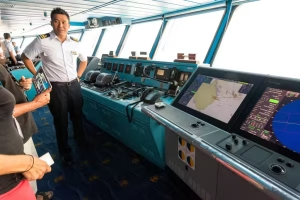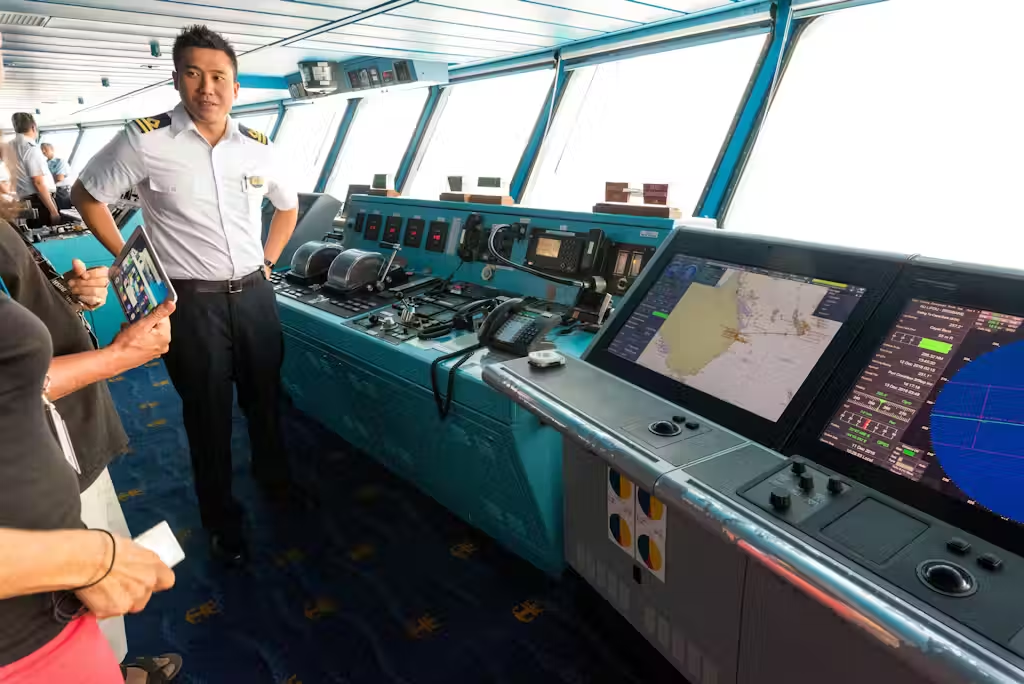In modern maritime navigation, Bridge Resource Management (BRM) is a critical area of study for ship officers, focusing on the effective use of all available resources—both human and technological—to ensure safe and efficient operations on the bridge. BRM plays a vital role in preventing accidents, improving communication, and enhancing decision-making processes during complex navigational tasks. At maritime academies and universities, BRM is an essential part of the curriculum, preparing officers to manage bridge operations under various conditions and in coordination with the crew.
This article explores the key elements of BRM, its role in ensuring safety at sea, and the importance of teamwork, decision-making, and risk management in bridge operations.

The Concept of Bridge Resource Management (BRM)
Bridge Resource Management is a set of principles and techniques designed to ensure that all available resources, including personnel, technology, and information, are used effectively to maintain the safety of a ship. BRM emerged in response to accidents caused by poor communication, ineffective leadership, and inadequate decision-making on the bridge. The International Maritime Organization (IMO) and industry regulators recognized the need for a formal approach to managing bridge resources, leading to the development of BRM training programs.
The core objectives of BRM are:
- Maximizing Safety: BRM aims to prevent accidents by ensuring that the ship’s crew works as a cohesive unit, fully utilizing technology and communication tools to navigate safely.
- Effective Use of Resources: BRM emphasizes using all available resources—whether human, mechanical, or informational—to make informed decisions and anticipate potential hazards.
- Error Management: By fostering a collaborative environment on the bridge, BRM helps to identify and mitigate errors before they lead to dangerous situations.
Key Elements of BRM
- Teamwork and Communication on the Bridge
Effective communication is one of the most important elements of BRM. Officers on the bridge must work together as a team, ensuring that information is shared clearly and promptly. Clear communication is vital in high-stress situations, such as during docking or navigating through congested waters.BRM training teaches officers how to give and receive clear instructions, manage workloads, and foster an environment where all team members feel comfortable voicing concerns or suggestions. This collaborative approach reduces the likelihood of errors caused by miscommunication or misunderstandings.
For example, during critical maneuvers, such as docking or emergency situations, clear and concise communication between the officer in charge, the helmsman, and other crew members is essential for smooth operations.
- Decision-Making and Situational Awareness
Situational awareness is the ability to understand and interpret the current state of the ship and its surroundings. This includes knowing the ship’s position, the behavior of nearby vessels, weather conditions, and any potential hazards. Maintaining situational awareness is crucial for making informed decisions.BRM training teaches officers to continuously monitor all available data—such as radar, AIS (Automatic Identification System), and ECDIS (Electronic Chart Display and Information System)—and use this information to anticipate and react to changing conditions. This helps officers avoid “tunnel vision,” where they may become overly focused on one aspect of the operation and lose sight of the overall situation.
In high-pressure scenarios, officers must be able to assess the available information quickly and make decisive choices. BRM emphasizes structured decision-making processes, which involve gathering input from the entire team, evaluating risks, and making the best possible choice based on the situation.
- Risk Assessment and Mitigation Strategies
One of the key components of BRM is understanding and managing risk. Officers must be able to assess potential risks and implement strategies to mitigate them. This involves identifying hazards early, assessing their severity, and determining the best course of action to avoid or minimize the risk.Risk assessment in BRM includes factors such as weather conditions, proximity to other vessels, traffic density, and the operational state of the ship’s equipment. Officers are trained to continuously evaluate these factors and adjust the ship’s course or speed as necessary to avoid dangerous situations.
For instance, if a vessel is approaching a narrow channel with heavy traffic, BRM principles would guide the officer in assessing the risks of collision, communicating with other vessels, and adjusting the ship’s navigation plan to ensure safe passage.
- Leadership and Assertiveness
Leadership is a crucial aspect of BRM. The officer in charge of the bridge must be able to lead the team effectively, providing clear instructions and ensuring that the crew is working in coordination. Leadership also involves being assertive when necessary, particularly in situations where quick decisions are required to avoid danger.BRM teaches officers how to balance assertiveness with openness to input from the crew. While the officer in charge is responsible for making final decisions, effective BRM ensures that all voices on the bridge are heard and that any concerns are taken into account before acting.
A good leader on the bridge will encourage open communication, ask for feedback from the team, and ensure that everyone understands their roles during critical operations.
- Workload Management and Fatigue Prevention
Managing the workload on the bridge is essential to maintaining the safety and efficiency of ship operations. BRM includes strategies for distributing tasks among the crew to avoid overloading any one person. This helps to ensure that officers and crew members can focus on their assigned tasks without becoming overwhelmed.Fatigue is a significant risk factor in maritime operations, as it impairs judgment, reduces situational awareness, and increases the likelihood of errors. BRM training addresses the importance of managing fatigue by encouraging proper watchkeeping schedules, rest periods, and monitoring the crew’s physical and mental well-being.
The Role of Technology in BRM
Modern ships are equipped with a wide range of advanced navigational and communication technologies that provide crucial data for decision-making on the bridge. BRM emphasizes the effective use of these technologies while maintaining the human element in decision-making.
- Integration with Electronic Systems: Tools such as ECDIS, AIS, radar, and ARPA (Automatic Radar Plotting Aids) provide officers with real-time information about the ship’s position, the movement of nearby vessels, and potential hazards. BRM teaches officers how to interpret this data and integrate it with the crew’s observations to make informed decisions.
- Alarm and Alert Systems: Many modern bridges are equipped with alarm systems that alert officers to potential dangers, such as proximity to other ships or shallow waters. BRM ensures that officers are trained to respond appropriately to these alarms while also cross-checking the information with manual observations to avoid over-reliance on technology.
Training and Certification in BRM
BRM training is mandatory for all ship officers and is required by the International Maritime Organization (IMO) under the Standards of Training, Certification, and Watchkeeping for Seafarers (STCW) convention. This training equips officers with the knowledge and skills necessary to manage the bridge team effectively, make informed decisions, and communicate clearly under pressure.
BRM courses typically cover topics such as:
- Team communication and leadership
- Decision-making and problem-solving techniques
- Situational awareness and risk assessment
- Fatigue management and workload distribution
Upon completing BRM training, officers receive certification, ensuring that they are equipped to handle the complex and dynamic nature of bridge operations.
Conclusion
Bridge Resource Management is a fundamental aspect of modern maritime navigation, playing a crucial role in ensuring the safe and efficient operation of ships. By fostering effective teamwork, enhancing communication, and promoting structured decision-making, BRM helps to prevent accidents and minimize risks on the bridge.
Through rigorous training in BRM, ship officers are equipped with the skills needed to manage bridge operations, lead their teams, and use the latest navigational technologies to make informed decisions. As maritime operations become more complex and technology continues to advance, the importance of BRM will only grow, ensuring that ship officers are prepared to navigate the challenges of modern shipping safely and efficiently.

